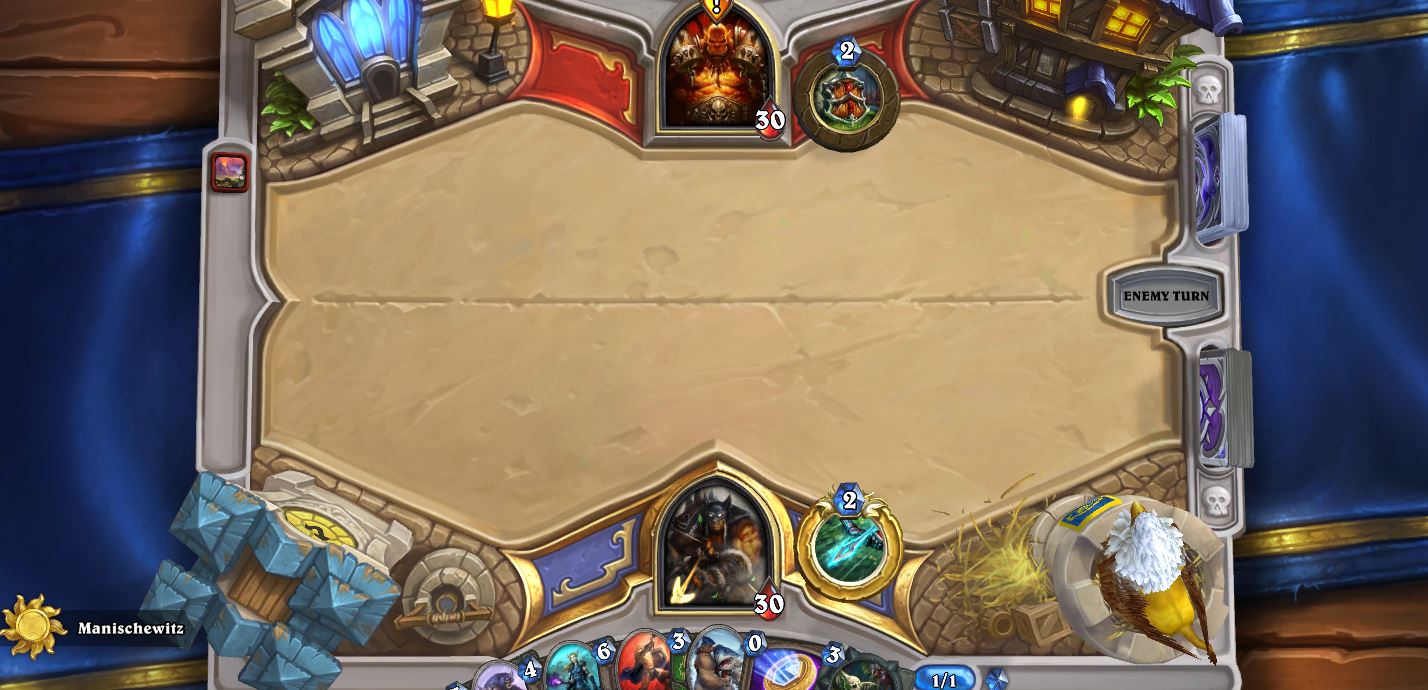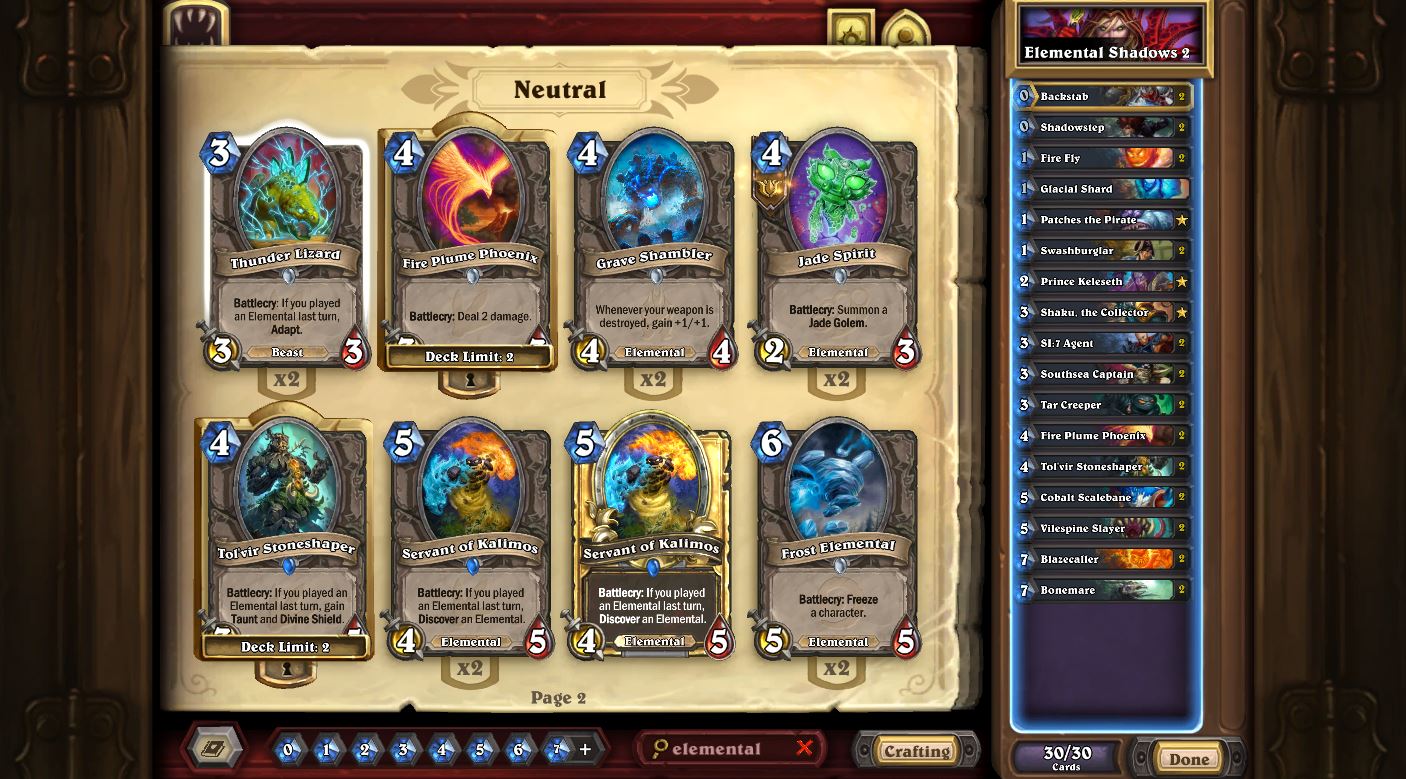Hearthstone doesn’t give players a great place to goof around. The Ranked modes for Standard and Wild, Hearthstone’s two main formats, are filled with people that are mostly focused winning (climbing the ladder, as they say). Casual mode, which doesn’t track wins and losses the same way Ranked does, should be a place where you’d find more interesting, experimental creations. But it isn’t.
Often one deck in Hearthstoneraises above others — as Secret Mage and Pirate Warrior did before Knights of the Frozen Throne, or as Jade Druid had before the Hearthstone development team’s recent round of card changes (aka nerfs) — the ladder can get rather boring.
When this happens, I tend to move either to the Wild mode — which consists of all Hearthstone sets — or Casual. But Wild also has found itself flooded with a couple of decks similar to the Standard ladder: Secret Mage and Pirate Warrior. So when I got miffed at Standard and Wild, I went to Casual. And one day this summer, I got fed up with Casual. I kept seeing the same two or three meta decks there. And I hated it. I was playing Casual to run away from those meta decks — and I thought that’s what the mode is for.
But in a recent conversation with Blizzard Entertainment’s Ben Brode, the game director for Hearthstone and the development team’s boss, showed me that I was viewing Casual from “a certain point of view.” As we talked, I learned that Brode and the development team’s viewpoint on Casual in Hearthstone might mean something different than how I defined it: “a mode where people aren’t playing meta decks.” I came away with more insight into what goes into designing different formats in a video game.
June 5th: The AI Audit in NYC
Join us next week in NYC to engage with top executive leaders, delving into strategies for auditing AI models to ensure fairness, optimal performance, and ethical compliance across diverse organizations. Secure your attendance for this exclusive invite-only event.
I hope you do as well. Here’s an edited transcript of our interview.
GamesBeat: What does casual mode mean to you as a game designer?
Ben Brode, Hearthstone game director: It’s different depending on your context when you say casual mode. You mean the casual mode we have implemented in the game right now, or just the concept of casual gameplay?
GamesBeat: The concept of casual mode gameplay.
BB: I think there’s an ideal and a reality. Casual mode, ideally, is just low stakes. I don’t have to worry about losing anything or having loss aversion. I don’t have to get my game face on and really try hard. If I have to be interrupted, I can turn it off at any point. I don’t lose anything. It’s totally fine. It isn’t hardcore competition where I need to be 100 percent focused and available. That’s the biggest goal of casual Hearthstone.
GamesBeat: Interesting. I’m just coming into it with a different definition, maybe.
BB: It’s possible. What I think your goal—I think the way you’d like to play Hearthstone, which we don’t have a great opportunity for you to do it in the game right now—tell me if I’m wrong, but it sounded like you wanted a mode where you could play more fun decks and not have to worry about meta decks, basically.
GamesBeat: Yeah, because those get boring to play against.
BB: I pulled a couple of stats, and I wanted to tell you a bit about the different modes and where I think they’re doing well in that respect, and where they’re doing badly, just to talk about some of the challenges of getting exactly what you want.

Above: Hearthstone’s casual mode is a no-stakes way to play.
First, I wanted to talk about casual mode. Right now, there’s an MMR, a matchmaking rating. The MMR goes up if you win games and goes down if you lose games. Starting out, we match you against new players if you’re a new player, and then we adjust your MMR so you can fight against players of similar skill. It’s not just skill, of course. People who are coming into the casual matchmaking to begin with have very limited collections, just basic cards, and then they start to accrue cards. It’s a component of what deck you’re using and your skill level. But players across the whole spectrum, even brand new players, get very close to a 50 percent win rate. As you win more in casual, that skill plus what deck you’re using will drive you to a higher MMR. The better you do in casual the more likely you are to see better decks, because those decks are good decks, and so they’ll push someone’s MMR up if they’re using them.
But if you’re not doing well in casual, you’re actually less likely to see those decks. Depending on your MMR, your experience of casual might be very different.
GamesBeat: I had no idea that the MMR was in place for casual mode.
BB: Yeah. It means you’re going to win about half your games. If you win less than half we’ll lower your MMR until you’re winning half your games. It almost doesn’t matter what deck you’re playing, or your skill level, or what deck you’re playing against. We’ll adjust your MMR until you’re winning half your games.
So in ranked, one thing you mentioned was that Pirate Warrior and Secret Mage were the decks you identified as being the most common meta decks. Actually, it’s very interesting. Your experience in ranked is also very different depending on what rank you are. At Legend, those two decks are about 14 percent of the meta, which isn’t a massive number. But you’re seeing them. At rank 20, those decks combined are only 5 percent of the meta. The experience of facing the same decks over and over again, seeing a lot of meta decks—most players are between rank 20 and rank 18, most active players. The experience for the greater Hearthstone audience is seeing a lot of different decks, not seeing meta decks anywhere near as often. Almost a third as often as players at Legend are seeing them. I mention that because there are parts of the game where the experience is very different depending on who you are. If you’re playing at low ranks, at a low MMR in casual, you’re not getting to the point where you’re seeing the same decks over and over again.
But I do think Hearthstone is more fun when you have a variety of experiences, so—anyway, one of the highlights is that it’s sometimes different depending on where you’re at.
GamesBeat: After your meaning of what a casual mode is, since you define it as being low stakes, does what you and the Hearthstone team has created achieve that definition?
BB: Yeah, I think it does. But I don’t—just because that’s one of my big goals for a casual mode doesn’t mean that your desire to have a place where you don’t play against meta decks isn’t a real thing. … A time where I felt I had the best match to that experience is fireside gatherings. It’s not like a thing you can just do at home. I don’t know if you’ve been to a fireside gathering. But we’ve added a ton of new features to support them. When you’re playing in real life with other players, you end up getting that experience. People are not necessarily playing to win, because there is no reward, unless you’re playing a tournament at a fireside gathering. People are showing off their creativity and their fun decks. I’ve had a ton of really fun experiences that are not feeling like I’m playing on the ladder, because it’s just this local environment with about 20 people and their fun decks that they could build with the collections they have. That, I think, is the closest match to the kind of experience you’re talking about.
GamesBeat: Do you have any plans to have some sort of daily mode where people can experiment and build decks without worrying about facing meta decks that they face on the ladder?
BB: I was thinking about this a little bit. Like I say, the desire is real. I think it would be fun for people to play in that mode. The question is, how would you do it? What is the way in which you would force that to happen? For example, let’s say, hey, we’re going to make a mode that’s Fun Only. This is fun mode. It’s not try-hard mode. We’re not trying to win. We’re trying to have fun. People have really different definitions of what fun is for them. For some people fun is trying to get Blood of the Ancient One to go off. For some people fun is playing an infinite combo, getting Antonidas and four Sorcerer’s Apprentices and Fireballing you over and over again, getting that crazy OTK [one-turn kill]. For some people fun is winning. Fun is just—I don’t like losing. I like winning. I like winning as much as possible. If you mix all of those people together, if you create a mode where these people are easier to beat because they’re playing bad decks and you say, “This is Fun Mode,” someone says, “Dang, that sounds great, I’ll play Pirate Warrior there and win a lot of games. That’s fun for me.” There isn’t really an obvious way to force players to play really bad decks. It’s subjective. And decks that used to be fun can sometimes can become very powerful and good. Silence Priest was kind of a fun deck, a meme deck with Purify. But it became very competitive. Suddenly it became one of the better decks.

Above: I played a lot of this Elemental Rogue deck … until the archetype got popular.
GamesBeat: Yeah. As soon as it became a better deck, I lost interest in it.
BB: Yeah, right? [Laughs] You want to be hipster. You want to play the decks no one else is playing. But other decks have done that. Grim Patron was kind of a fun, silly deck that quickly became—oh, actually that deck’s really good, maybe it’s the best deck? Decks can change in power level over time. It’s a subjective thing. It’s hard to agree on what decks are good or not good. You can have a deck that no one’s discovered and all of a sudden people realize there’s power in it, or change a couple of cards and now it goes from fun decks only to one of the best decks in the game. There’s no obvious way to force a subjective rule set on players in that way. I think casual and ranked do end up getting close to the experience, depending on what rank you’re playing at. But it is hard. I don’t think it’s crazy to pursue that, though. It’s a noble goal, and I think it’s something we should continue to brainstorm on. At least it’s currently not obvious to me, how to get exactly that as a mode that players can count on not seeing—a mode with decks that everyone would agree, yeah, those are fun decks, not powerful decks, and people aren’t trying to just win as fast as possible.
GamesBeat: What about putting those choices in players’ hands, with a sort of sandbox mode where they can build their own tournaments and ban certain cards?
BB: I think that’s great. The idea of community-run tournaments is very exciting. It’s already happening right now. [One] did something very similar to what you’re talking about, where he ran a tournament and banned a couple of cards. That’s super-cool to me. Right now the process is a little bit more difficult, because there’s no manual admin. It’s not something supported directly in the client. But I think that kind of feature could be very compelling, especially at fireside gatherings, where you have a bunch of people in a real space together. We like empowering our innkeepers who are running the fireside gatherings to do that exact kind of thing – have some crazy modes. I saw a tournament in Kansas City where they had a spinner. You spun the spinner, took out your camera, shot a QR code, and that was the deck you played in the tournament. That’s fun. It focuses on the pure fun and joy of playing Hearthstone, not on competition. Some people are competitive and that’s great. We want to support that too.
But also, it’s good to try and find ways for different people who have different goals and different things they get fun out of from Hearthstone—we should be looking at ways to support that as well.


